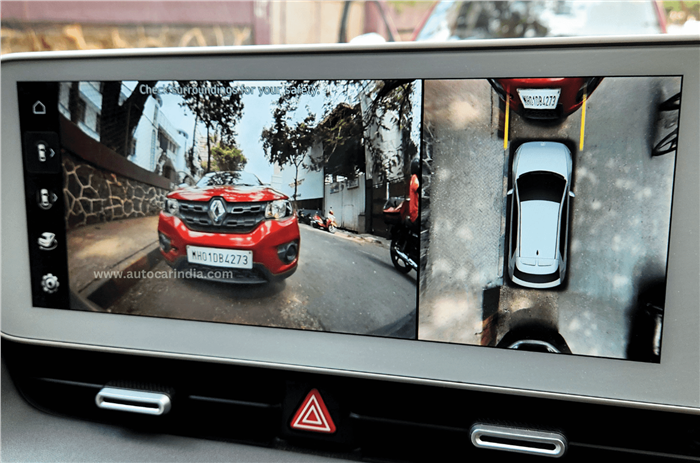First report: Hustling through the daily grind in Hyundai’s flagship EV reminds us why our jury voted it Car of the Year 2024.
Few long-term cars I’ve run have elicited as many questions from my rotating set of passengers as the Hyundai Ioniq 5 has. The exception might be the MG Comet, but in its case, people are simply amused by its quirky design and tiny size. The Ioniq comes from much further up the EV pecking order and the questions I get about it are far more serious and pointed. They’ve covered everything from range to charging and the wider topic of running costs, as well as simpler stuff like space, ground clearance and looks. But the two that I’ve gotten the most in my brief time with this new long-termer are “Rs 50 lakh for a Hyundai?” and “How could a big, expensive EV win Autocar India’s Car of the Year award?”

Super-clear surround camera makes parking the big Ioniq a whole lot easier.
Luckily, there’s a common answer to both those questions, and it’s being reinforced with every new kilometre I put on TN 87 D 7068. In short, it’s just that good, to the point that Rs 50 lakh starts to sound like a bargain. It may be the most expensive Hyundai, but that’s because it’s the best Hyundai has to offer, by some margin. It outshines luxury SUVs that cost way more, and when you consider that its sister car, the Kia EV6, costs Rs 15 lakh more, you realise how shrewd Hyundai was to locally assemble it. And they haven’t skimped on gizmos either; it packs in just about every hot feature today, as well as some parlour tricks that are purely there for wow factor.

Retro-cool ‘pixel’ headlamps and LEDs on bumper top look incredible at night.
For example, it sounds silly to line the surface of a car’s front bumper with LEDs, but they have, and I’d be lying if I said it doesn’t bring a smile to my face every time they light up. Similarly, the pixel-like LEDs in the headlamps and tail-lamps fit in so well with the retro 1980s aesthetic of the car on the whole. Then there’s the huge glovebox that slides out like a drawer. The fact that there are several cubbyholes between the front seats, yet enough open space tells you it’s a born EV. There’s even the ridiculous option of flattening both front seats into a bed-like arrangement; can’t imagine when you’d ever use that, but it’s there.

Regularly delivers over 6km/kWh during my trafficheavy city commute.
Some quirks aren’t as successful in my opinion, like the column-mounted drive selector. Mercedes cars have this too, but in the Ioniq, it is in addition to the indicator stalk, and I constantly mix the two up. Plus, the twist-to-select system for drive and reverse feels counterintuitive, and I still get it wrong even after two weeks. Like our long-term Creta, this too has white upholstery, but here it extends to the doors and dashboard, and expectedly, frequent contact points have turned brown. There is a black option available now, though. Those pop-out door handles may be cool but water collects inside their housing every time the car is washed, which mixes with any dirt to leave a mucky residue on your hand when you open the door. And finally, though I love that they’ve gone against the trend and committed to huge and handsome 20-inch wheels for India, their flat design means they’re very easy to kerb; in fact, the car came to us with all four wheels scuffed!

Sergius and I swap between the big, comfy Ioniq and the small, zippy Comet.
While on the topic, those wheels are one of many elements that disguise just how massive the Ioniq actually is; the wheels pushed to the outside, its hatchback shape and clean lines are the other factors. The wheelbase is actually 3,000mm (more than a Mercedes GLE) and only when I parked it alongside our long-term Tucson did I realise the two are about the same size. Where it initially felt its size was on the road, more so for me who switched from the Comet: the smallest car on sale today. Light controls and good visibility mean I’ve acclimatised pretty quickly though, and despite it feeling like it wouldn’t clear bigger speed breakers with that long wheelbase, I was soon reminded this is a crossover with plenty of ground clearance.

Huge 20-inch wheels easy to scrape on kerbs; the car came to us with all four scuffed.
EV stuff? The range is tremendous, not only thanks to the 72.6kWh battery but also because efficiency is high. Though I used to get a little carried away with the 217hp in the early days, now I easily manage upwards of 6km/kWh on every office commute. Charging is super quick too; up to 350kW on a fast enough DC gun. And when Sergius borrowed it one weekend, he was able to get it from 21 to 73 percent in just 15 minutes. There really is a lot to like—and talk about—with the Ioniq 5, so stay tuned for future reports.
Also see:
Hyundai Ioniq 5 N review: N-thusiasts assemble
Next-gen Hyundai Palisade global debut by early 2025
Hyundai Alcazar gets up to Rs 70,000 in discounts this month

